If you have opened to this article and begun to read, you likely have a strong connection to traditional bowhunting and with it the history of our ancestors who carried these primitive weapons to pursue game not as a pastime but as a means of survival. While I like to believe that I have adopted this primitive lifestyle as a means of sustenance, it is a hard-fought argument when the nearest grocery store is a 30-minute drive from my front door. I still feel a deep-rooted connection to our hunter-gatherer forebears when I take to the woods with stick and string.
If we look back far enough into our history, we can find that weapons of choice yield to technology, and other means of pursuit materialize, from the disguised hunters wearing the furs of wolves to the use of domesticated animals and stock. Petroglyphs over 8,000 years old show the use of dogs in pursuit of game on the African continent, nipping at the heels of lions and gazelles. The hunting tradition began from necessity and has evolved to a point where killing efficiency has forced us to show restraint, yet some traditions die hard.
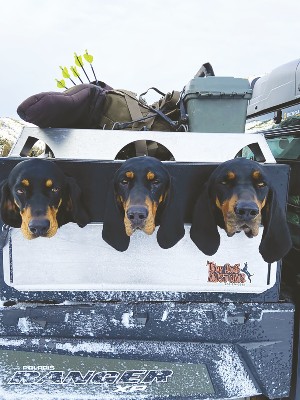
The long-eared gang: Moose, Josie, and Kimber.
Many of my youthful years were spent alongside my father furthering the tradition of hunting with a dog. He was a trainer of bird dogs, who aided in finding and retrieving upland birds and waterfowl. The innate drive of a hunting dog is not something you can train into its behavior. Their bloodlines have carried these skills through reproduction, and we trainers are only here to refine and focus their attention while building a working relationship. Respect is given and received. The owner and canine learn to understand the nuances of each other’s sounds and gestures, ultimately working flawlessly in the field toward a common goal. It was through these lessons I developed a passion for the working dog. From herding stock to pursuing and hunting big game, each breed has a purpose.
After school and well into my journey with traditional archery, a black and tan coon hound named Moose entered our family. By then, I’d had the opportunity to hunt with hounds for several years, without being able to convince the rest of the family that owning a pack of long eared, loud-mouthed hounds would be a wise decision for our modern-day lifestyle. Late in November 2016, I made the commitment that I would be bringing home this young puppy right around the Christmas holiday, thinking perhaps I would be able to pass him off as a present with a large red bow wrapped into his tangled ears. Moose was out of a well-established kennel in western Utah known for their AKC black and tans, bred for their cold noses, fast legs, and long bawls. The romance of becoming a houndsman occupied my thoughts for the remainder of that winter.
Not having the slightest clue where to begin, I reverted back to the lessons learned by observing my dad all those years working with bird dogs, the most important of which was to grow a relationship based on respect. I would drag sausages and watch him trip over his ears as he worked the scent to be rewarded with a salty treat tied to a low hanging branch. We would hike through deep snow until he would ultimately give in and whine for a ride home in my backpack. Each night he could be found in the corner of the living room curled up on a soft sheep skin blanket. Dreams of pursing a lion that first winter were all that they turned out to be. We were both toddlers riding around with our training wheels.
Later that spring I picked up a second puppy from the same line out of Utah. She was a polar opposite from her broad-chested brother. Think about a ballerina and a lineman. Moose tips the scales close to 70# and sports a set of ears close to a foot long, while Josie, as she became named, was a dainty, mouse faced hound with a brain. Immediately it was evident that she would require a soft hand to guide her, but the primal instinct to pursue game by use of her nose was ever present. Working the two of them consistently through the summer months, heavily focusing on obedience, we walked into that first season as a team, albeit a novice one.
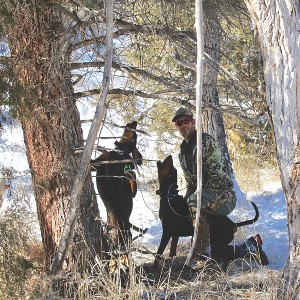
Moose, Josie, and Kimber treed on a good lion during their second season.
Fortunately for us Moon, an experienced hound, joined our ranks early that December. He was young, but had a knack for sniffing out a cold lion track regardless of the condition. In his first season he had seen several dozen treed and had just enough talent to offer a stark comparison to me and my couch hound biscuit eaters. Moon showed the stereotypical traits of a cold nose hound from western Colorado: red, bloodshot eyes, long ears, and dopey smile, yet he was white as the snow. Late that December, that hound showed me and the kids to our first lion tree.
I hold fast to the idea that we as the houndsmen are equivalent to a coach on the sidelines. Sure, I found the track, and I had worked with the dogs incessantly to correct their minor behavioral flaws, but when their noses hit the ground, it was apparent they were following the lead of a tradition deeply ingrained in their DNA. The remainder of that season we failed, succeeded, and learned as a team. We followed countless tracks to end on a burned south facing slope or to be duped by a clever log-hopping bobcat. Yet the reward of watching the three of them begin to work like a team, honoring each other’s leads and pushing a track nose to tail, always outweighed the effort put forth into the countless failures.
With the headaches of a puppy fading into our memory, we decided to round out the pack with a third black and tan. Kimber, a stout female, joined the ranks when she was eight weeks old. Thrown from the same maternal line as Moose, she sported a similar set of oversized ears and a long snout, looking as houndy as they come. With the attitude of a hornet, I’m not sure we would be in the same place we are today had she been my first introduction to the breed. From an early age she was rooting out the mice in the backyard and doing her best to chase down anything with four legs. She found every weakness in our fence as a prisoner would trying to escape from Alcatraz. At the ripe age of seven months, she joined the pack on the first lion track of the year.
To watch her nose hit the track and catch the first of the scent evaporating out of the cold snow was further evidence of the drive so deeply connected to her soul. The second she touched the snow with the tip of her snout, her head whipped back, letting out the familiar call of a hound. A mere 30 minutes later, I was walking up to the dogs cutting wide circles around the base of a tall spruce marooned on a steep chute. That is, all but Moon, who was locked-in sitting on his haunches and staring a hole through the top of the tree where a long tail drifted between offset branches. Hubris wasn’t hard to feel then, a feeling similar to what I now find as a new father watching my daughter take her first steps.
During that second season the scales began to tip, with more days ending at the base of a tree than not. The rodeos chasing dogs from one end of the county to the other became slightly less frequent, although still present. We were moving on from the freshman team to the JV squad. We had much to learn about the details of moving through varied terrain when our quarry took an inaccessible route, the nuances of scent and its ever-curious behavior, and the determination required to push a cold track through windswept, sun burnt hills. We ran from the far western reaches of Colorado to just out our backdoor along the front range.
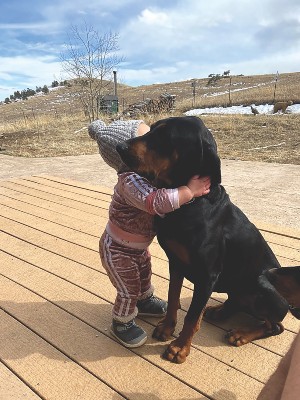
The author’s daughter, Ophelia, with her best friend Moose.
One thing I became certain of is never to fool yourself into thinking you understand the mind of a cat. Days when a fresh coat of snow covered the ground and I was convinced we would end up at a tree in no time, turned into miles on miles through rough, varied terrain chasing a young tom cat just out exploring his range. The hounds, however, began to think like a lion. When the scent seemingly disappeared into thin air along a rocky face, they would not turn in the towel as they might have been inclined to with less experience. Instead, they began to understand what they were chasing and would begin making circles on circles in an attempt to pick the trail back up. With each success, they gained confidence. The momentum continued late into spring when the season closure forced us back onto the porch for the warmer months.
In October, just prior to the start of the second season, our daughter Ophelia entered the world. The dogs picked her up as if she was another addition to their pack. As she grew and her mobility increased, she tested their boundaries, extending her body over theirs and listening to them grunt in response. The intellectual capability of a hound extends beyond the hunt. Just as they learned their pursuit, they learned the boundaries and roles as they changed with the new family member.
In the hot months of summer as Ophelia matured, so did they. Even Kimber started to lose the wildness of a young puppy, maturing into a faithful and obedient companion. Moose and Josie both transitioned easily into an offseason, while Moon’s temperament was unchanged. He was the Eeyore of the group, only showing spark in his eyes when scent of a lion entered into his nose. He was an old soul in a young dog’s body, methodical, meticulous, and slightly delusional at times. His understanding of a lion is something I cannot put into words. He could pick up a three-day old track and push it step by step while the other dogs were busy chasing a squirrel up a nearby tree. When he didn’t have his nose to the ground, he was usually stretched out in the sun, the only sign of life being the movement of his chest as he breathed.
One morning late in the summer, I awoke to the sound of a hungry chorus outside our bedroom door. In ritual fashion, the three black dogs found their places and sat back awaiting their breakfast. Moon, however, was in the hall. He didn’t have much of an appetite and after nibbling a couple of bites he walked outside and assumed his position in the sun. In an attempt to lie down, he lost his footing, his back legs falling from under him. Moon may have had a lethargic personality, but this was different. My heart broke as I worked to help him to his feet and bring him to a spot to rest. We followed protocol, visiting the vet and completing diagnostic testing, but within only a day of progression he could not lift his head.
That weekend was my daughter’s first birthday and the night of her party, Moon’s old soul left us. The feeling of losing a companion was indescribable. He had been solely responsible for our team’s success to date. While I enforced obedience with the puppies, he was the spark that ignited their ancestral drive to hunt.
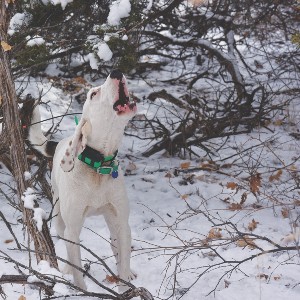
Moon treed on a Christmas day bobcat.
We mourned and life continued with a new routine, until an early November morning as I stood over the first track of the year with the box short one hound. The confidence we had built the previous season was compromised by the loss of our quarterback. I was anxious, not knowing how the three of them would work without their leader. I dropped the tailgate and watched as their tails rose with excitement, with Moose first to open and take the track with Kimber and Josie in tow.
After overrunning the track several times and taking a few side paths, they worked their way along the back of a knoll and into a steep canyon as I faithfully followed. Cresting the ridge, I could hear their voices ringing off the rock walls signaling treed. Not a man of traditional faith, I still looked to the sky and thanked my good friend for the lessons he had left behind. With a pinch of his ashes between my fingertips, I released him into the wind.
Without our lead we had taken a step back, but through those next four months we learned and grew together, each filling a piece of the role Moon had left behind. We had our successes on lion and bobcat but kept our confidence in check with an occasional rodeo. For each treed cat, we had a successive walk of shame out of some deep hole after losing a track to the rocks. After each hard day, we retired to the couch with our girls welcoming us home. Perseverance and drive began to pay as our batting average increased through the later spring months. Warmer mornings precipitated difficult conditions, but allowed for the rest of the family to join in our adventures. A hearty Mom left little choice for Ophelia, as she would load her into a backpack and follow along behind those long bawls.
With one last wet spring snow, we were left with one of the largest tracks I had seen in that country. He had crossed out of a deep rocky canyon, traversing the ridge line ending perpendicular to the unimproved road. His stride was short, truncated by the grade of the hillside, but the round marble-like toes were unmistakably those of a large tom. As I surveyed the track, the hound’s voices created a cacophony inside of the wooden box as they gnawed at the door pleading to be released. I loosened the bolt and watched as the team hit the ground in stride. With the large cat leaving a hot track in the moist snow they made quick work of the trail, which we followed. From the first to the last track of the season, my confidence had grown immensely. It wasn’t that I knew we would trail flawlessly, but rather I knew the heart of these hounds was true and their drive would lead us to a tail swaying between the standing pines.
Hannah, my wife, and Ophelia followed as I picked our way down to the base of the tree. The entire family was enjoying the hounds’ music, with a trophy tom laid out across a Y in the branches. With the dogs tied back, I watched as the limbs on Hannah’s bow bent and the arrow flew true to its mark. With an incredible amount of power, the cat launched toward the ground to be recovered a short distance later. More than any other hunt, satisfaction did not come with the final arrow. The hours, days, and years spent living and working with these dogs is the source of my fulfillment.
The story is far from over. As with most of my pursuits, I started down this path with the intent of finding adventure. We have since adopted these hounds as an extension of our family. Our daughter will grow-up knowing the heart of a hound, passing along the lesson of persistence while leaving their saliva stains on her shirt. Our hounds have sparked a resting ember igniting a primordial drive to hunt and pursue a way of life akin to those who have come before me.
- Moose hugging a tree in which he has a lion at bay.
- Hannah walking up to hounds baying at a tree with Ophelia on her back.
- Hannah squaring up on the large tom positioned high in the tree above.
- Hannah and her large tom taken after a late April snow shower.


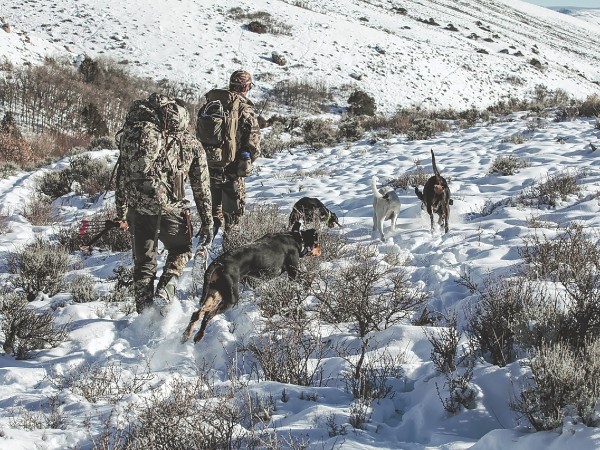




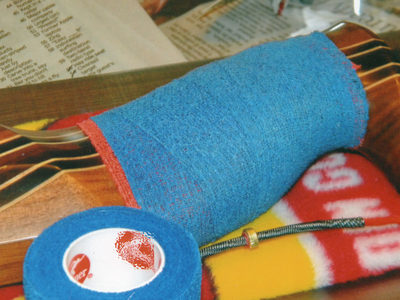
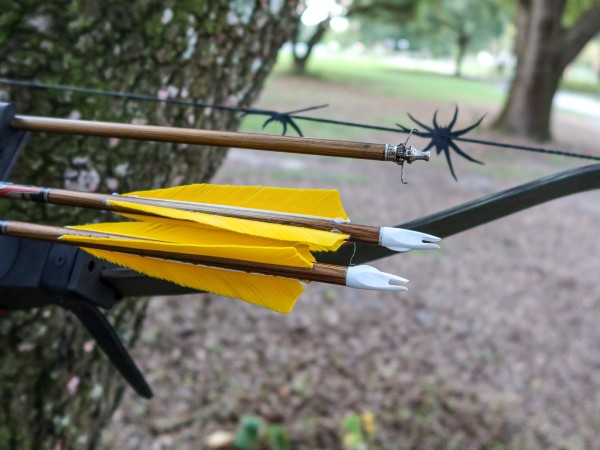


Leave A Comment